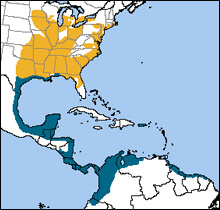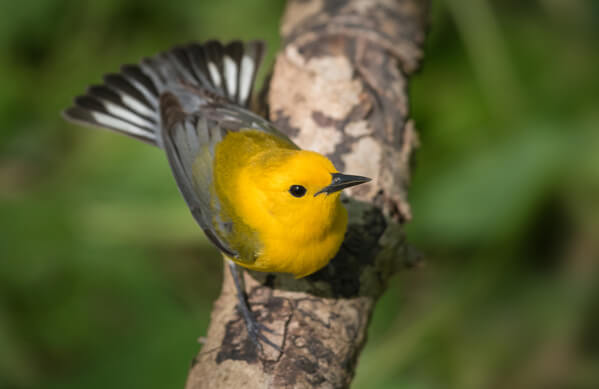 This warbler looks like a bit of spring sunlight with its golden-yellow head and breast set off by blue-gray wings. "Prothonotary" refers to clerks in the Roman Catholic Church, whose robes were bright yellow.
This warbler looks like a bit of spring sunlight with its golden-yellow head and breast set off by blue-gray wings. "Prothonotary" refers to clerks in the Roman Catholic Church, whose robes were bright yellow.
Habitat loss and competition for nest holes are a problem for this species, which is one of only two cavity-nesting North American warblers. (The other is Lucy's Warbler.)
In addition, brood parasitism by Brown-headed Cowbirds, which enter the warbler's nest cavity to lay their eggs, is a significant problem on the birds' breeding grounds.
Stream-side Songbird
This species, a priority of our Migratory Birds program, breeds in the southeastern United States and winters in coastal mangroves and streamside lowland forests in Central America and northern South America. It migrates relatively early in both spring and fall.
The Prothonotary Warbler shares its swampy habitat in the breeding season with other birds of conservation concern, including Yellow-billed Cuckoo, Red-headed Woodpecker, and Cerulean Warbler.
Sign up for ABC's eNews to learn how you can help protect birds
To a Prothonotary Warbler, a great breeding habitat features dead snags and trees full of holes, always near water—whether rivers, swamps, or bottomland forests. The male bird's simple, melodious song is a series of loud, repeated “zweet” notes.
Cavities low in trees, such as holes excavated by the Downy Woodpecker, are prized as nest sites. However, the species will also nest in man-made cavities such as nest boxes.
When it comes to food, Prothonotary Warblers aren't terribly particular. They feed primarily on aquatic insects but will also take spiders, seeds, and snails gleaned from tree trunks, fallen trees, and leaf litter on the forest floor. The birds also feed on snails and supplement their diet with fruits and nectar.

Prothonotary Warbler by Ray Hennessy, Shutterstock
Defending the Nest
This warbler is extremely territorial during the breeding season. The male defends the territory by chasing away intruders or snapping its bill, while the female will also enters into bill-snapping disputes with other females.
The male selects and prepares a nesting spot before trying to attract a mate. He lines the nest cavity with moss and may build “dummy” nests to expand his territory and provide optional nesting sites.
Once the male wins a mate, the female takes over nest building, adding materials such as rootlets, plant down, and other materials to the nest cup.
The female incubates the eggs, but both adults share parental responsibilities, such as bringing food to the young and protecting them against intruders. The adults continue to supervise the fledglings for around 35 days after they have left the nest.
A Bright Future for Prothonotary Warbler?
Today, populations of Prothonotary Warblers seem to be stable and may actually be increasing, due in part to the provision of nest boxes. It is still a species of concern, as it's one of more than 200 birds included in the 2014 Watch List. Our work with the Sustainable Forestry Initiative in the southeast United States will help to provide nesting habitat for this species, along with Wood Thrush and Kentucky Warbler.
In addition to restoration of forested wetlands on breeding grounds, conservation of mangrove forests is urgently needed on the wintering grounds to keep this lovely bird returning each spring.
Donate to support ABC's conservation mission!



















































